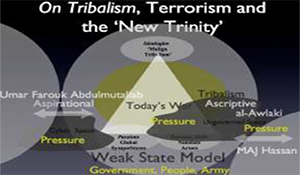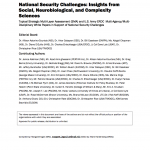National Security – Social & Complexity Science Insights

National Security Challenges: Insights from Social, Neurobiological, and Complexity Sciences.
Author | Editor: Astorino-Courtois, A. (NSI, Inc), Cabayan, H. (Joint Staff), Casebeer, W. (DARPA), Desjardins, A. (NSI, Inc), DiEuliis, D. (HHS), Ehlschlaeger, C. (ERDC), Lyle, D. (USAF) & Rice, C. (USA/TRADOC).
This White Volume assesses U.S. long term national security challenges, employing a global perspective that accounts for the changing political, economic, social, and psychological profiles of populations, and the rapid changes they experience in a globally connected information en- vironment. It addresses many of the key national security challenges iden- tified by LTG Flynn in the Preface. The collection of essays explores future population-centric national security challenges through the lens of the lat- est research from the social, neurological, and complexity sciences. The papers emphasize “enduring” long term themes that are focused on the in- teractions of populations and their environments. They are not U.S.- centric, but multi-perspective and examine underlying long term phenom- ena.
The target audiences are planners, operators, and policy makers. With them in mind, the articles are intentionally kept short and written to stand alone. All the contributors have done their best to make their articles easi- ly accessible.
This white paper addresses many of the key national security challenges identified by LTG Flynn in the Preface, including the following:
- The threat environment is highly asymmetric, amorphous, complex, rapidly changing and uncertain.
- There is need for speed and flexibility in U.S. intelligence gathering and decision making.
- Current analytic deficiencies arise from the Cold War structure and in- sularity of the IC, complexity of the environment, and how we currently think about threats.
- New thinking needs to consider populations as important actors (e.g., mobilization via social media, etc.) and the social and resource inequi- ties and grievances that spawn conflict.
- Following the end of the Cold War, the expected “peace dividend” has failed to materialize; the U.S. has experienced an era of persistent conflict
General Flynn’s remarks suggest a number of specific challenges to ana- lysts and planners:
- Reevaluate our concept of what constitutes a “threat” in the current and evolving world environment both from a U.S. and foreign perspec- tive.
- Expand the sources of information used to understand the environ- ment.
- Consider the population of an area as an important actor; also, assess outside entities within the periphery of destabilization that have the ability to leverage support to insurgent groups, which will negatively effect U.S. operations.
- Be proactive; focus on the causes and precursors of conflict rather than solely war and conflict.
- Learn to understand and respond flexibly and faster; be more “adap- tive” and forward thinking.
The overriding theme in this White Volume is how best to assess U.S. long term national security challenges, employing a global perspective that ac- counts for the changing political, economic, social, and psychological pro- files of populations, and the rapid changes they experience in a globally connected information environment.
The target audiences for this White Volume are planners, operators, and policy makers. With them in mind, the articles are intentionally kept short and written to stand alone. All the contributors have done their best to make their articles easily accessible. The papers emphasize “enduring” long term themes that are focused on the interactions of populations and their environments. They are not U.S.-centric, but multi-perspective and examine underlying long term phenomena.
In describing these long term challenges, it is important to remember that we are dealing primarily with human behavior rather than physical phe- nomena. Methods involving mechanistic approaches and point predictions will not be feasible; rather we will describe techniques to map out ranges of possible futures. The difficulties are increased because security threats are global in scale and must be anticipated as far in advance of a crisis as possible. Multidisciplinary approaches are called for and validation of models may be difficult, costly, or in some cases impossible.
This collection of essays explores future population-centric national secu- rity challenges through the lens of the latest research from the social, neu- rological, and complexity sciences. The first section, Populations in their Environments: Factors Impacting the Fragility of “Peace,” argues that an understanding of a population’s propensity for social and political conflict is not possible without an appreciation of how its needs and interests re- late to and are affected by the physical environment. The second section, Global Patterns and Trends in Armed Conflict: Evidence and Theories, describes recent and ongoing research on historical patterns and trends in armed conflict, which have documented a systemic decline in armed vio- lence worldwide since the end of the Cold War, even as the U.S. has expe- rienced an “era of persistent conflict.” The third section, Neurobiological, Cognitive and Social Science Insights on Radicalization and Mobilization to Violence discusses the neurological and cognitive drivers of the social behaviors that propel people to radicalize and pursue violence. The fourth section, Seeing the World As it Is: Complex Adaptive Systems Approaches as Multi-source, Multi-input Integrators discusses the potential of complexity science to help us combine insights from the other disciplines into a coherent system of understanding, and apply this framework directly to the challenges military planners face. The fifth section, written by Admiral James Stavridis and Dr. Evelyn Farkas, speaks to the importance of partnership and collaboration between public and private organizations to achieve mutually desired security outcomes. Finally, Dr. William Casebeer from DARPA provides an epilogue considering insights from the first two sections and how the complexity sciences might be employed to address the challenges faced by strategic thinkers, military analysts and planners, and decision makers.
Contributing Authors
Dr. Janice Adelman (NSI), Mr. Azad Amir-ghessemi (PERTAN Inc), Dr. Allison Astorino-Courtois (NSI), Dr. Greg Berns (Emory University), Dr. Belinda Bragg (NSI), Mr. David A. Browne (PACOM), Dr. Emile Bruneau (MIT), Mr. Jeffery Burkhalter (USA/ERDC), Mr. William Busch (EUCOM), Dr. Hriar Cabayan (OSD), Dr. Bill Casebeer (DARPA), Ms. Abigail Chapman (NSI), Dr. Joan Chiao (Northwestern University), Dr. Claudio Cioffi-Revilla (George Mason University), Dr. Eric Dimperio (USA/ERDC), Dr. Diane DiEuliis (HHS), Ms. Marina Drigo (PERTAN Inc), Mr. Patrick Edwards (USA/ERDC), Dr. Charles R. Ehlschlaeger (USA/ERDC), Dr. Evelyn Farkas (EUCOM), LTG Michael Flynn (DIA), Dr. James Giordano (Potomac Institute for Policy Studies), Dr. Peter Hatemi (Penn State University), Dr. Cullen S. Hendrix (College of William & Mary), Mr. Eric A. Knudson (PACOM), Mr. Joseph T. Lee (PACOM), Mr. Kalev Leetaru (University of Illinois at Urbana), Lt Col David Lyle (USAF), Dr. Rose McDermott (Brown University), Ms. Shana McLean (EUCOM), LTC (Dr.) Rob Neff (SOCOM), Dr. Anthony Olcott, COL (Dr.) Christopher Rate (SOCOM), Dr. Christopher Rice (USA/TRADOC), ADM James Stavridis (EUCOM)

Comments